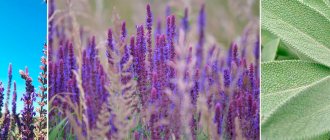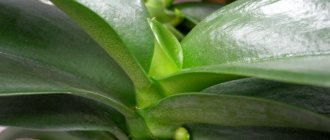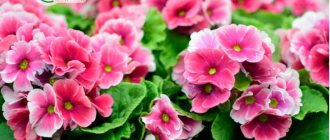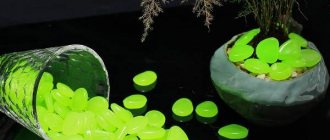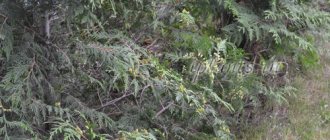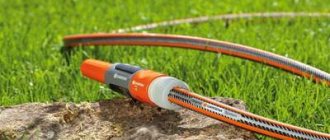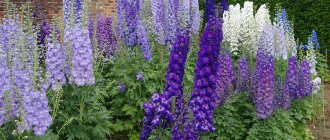Thuja is one of the most popular coniferous plants, which is used for ornamental cultivation. One of its main advantages is its relative unpretentiousness to the conditions and quality of the soil, however, to ensure the comfort of this plant, you need to know some of its features, which will be discussed in detail in this article.
When is it better to plant thuja: in spring or autumn
The unpretentiousness of thuja also lies in the possibility of planting this plant in open ground at virtually any time of the year. Many gardeners consider it most favorable and carry out this process in the spring, since this gives the seedlings enough time to adapt to new conditions and prepare for the first wintering, and also ensures the connection of the plant’s life cycle with the biological clock.
In this case, the following conditions must be met to help the plant take root:
- You should not delay time when planting in spring; it should be done as soon as weather and temperature conditions allow. This is due to the fact that young bushes tolerate changes in environment much better and take root more successfully in a new place.
- When planting, it is necessary to preserve an earthen ball around the root shoots in which the seedling grew in a pot.
- Simultaneously with planting, complementary feeding is carried out with a mixture consisting of turf, peat and sand.
- It is recommended to add about 50 grams to the soil during planting. nitroammofoski. The dosage can be increased depending on the number of bushes planted.
Thuja tolerates autumn planting well, but when implementing it, you need to take into account some features:
- Planting in open ground should not be done in late autumn ; it is usually carried out from early September to mid-October, since then the first persistent frosts begin. A bush unprepared for new conditions of existence may not survive them.
- The soil near the tree trunk should be insulated with fallen pine needles or a layer of compost , which will protect it from the first frosts.
- Fallen snow will need to be removed from branches that are not yet strong , since they can break under its weight.
Stamping
An artificially formed tree is called a trunk. The height of such a plant is 1–2 m. In relation to the tree-like thuja, this process will consist of the gradual removal of the lower branches. The result will be a part of a bare trunk, above which a lush crown will rise. Considering that it is impossible to cut off more than 30% of the branches at once, the gardener will need several years to form the desired shape of the thuja. Whether this should be done and whether such a thuja will be beautiful is up to you to decide.
Features and rules for planting thuja
Thuja has a number of features regarding its planting; all the most significant nuances of this process are discussed in detail below:
- For cultivation, it is recommended to take seeds that are inside the cones and ripen in the autumn. The process of growing a seedling will be long and will take about 5 years, but a bush that originally grew in local soil will be more adapted to climatic conditions.
- When choosing a place for planting, you must remember that this plant does not like sunny areas. An abundance of lighting will not have a positive effect on the bush and will not provide it with warmth; on the contrary, frosts will be tolerated much worse.
- Too dark places are also undesirable , since in them the thuja quickly loses its visual appeal; the ideal option would be partial shade.
- When choosing a place for planting, you need to make sure that it is sufficiently protected from drafts and cold northern winds.
- Many plants do not tolerate close groundwater , but thuja is an exception in this regard; such a place will be considered very favorable for its cultivation.
- Errors in correctly determining the location for planting are not critical , since this plant tolerates replanting well and, if necessary, can be easily moved.
Step-by-step instructions for planting thuja
To quickly adapt the bush after transplantation into open ground and its subsequent normal development in new conditions, it is necessary to follow the technology of this process. A detailed algorithm of actions is given below:
- Initially, a hole for the bush is prepared, its depth should be at least 70 - 80 cm , the optimal diameter is about 100 cm, however, these indicators can be adjusted depending on the size of the earthen ball in which the root shoots are located.
- A small amount of soil is placed at the bottom of the prepared hole , into which organic fertilizers have been added. It is recommended to add wood ash.
- The bush is carefully immersed inside the hole , while care must be taken not to damage the earth ball.
- The root collar of the plant after immersion in the hole should be strictly at the same level with the soil surface.
- Garden soil is mixed in equal quantities with peat and sand, after which the hole is filled with this mixture. It is best to pre-heat the sand, since it often contains various parasites that can cause dangerous diseases.
- The soil poured into the hole should be lightly compacted , after which it is abundantly moistened with water.
If you are planting not just one, but a whole series of bushes at once, then additional rules must be taken into account:
- A free space of at least 1 meter must be maintained between planted miniature species
- Between large rocks, the distance should be increased to 5 meters , since over the years they grow greatly and increase in diameter.
- When creating hedges, the distance between bushes is no more than a meter, regardless of their species and expected size.
Preparing for winter
Starting from September, the plant is not fed; it is necessary to slow down the growth of shoots for normal wintering. Before insulation, you need to thoroughly moisten the soil to a depth of 30 cm from the surface. After watering, a layer of dry leaves, tree bark or straw up to 10 cm thick is raked around the trunk.
Spruce branches are additionally placed on top. The branches need to be tied, otherwise the snow layer can break them with its weight. If it is possible to visit the site in winter, then it is advisable to remove snow from the shoots and, on the contrary, shovel it into the tree trunk circle.
Even a beginner can grow an evergreen beauty; no special knowledge or skills are required. You just need to learn the rules of watering in different weather conditions, the frequency of fertilizing and preventive measures.
Aftercare
The process does not end with planting, since in order to create comfortable and favorable conditions, the thuja will require subsequent care, which will consist of the following:
- Thujas love abundant watering; with a lack of moisture, the quality and appearance of the needles first deteriorate. In this case, the plant responds best to natural moisture and rainwater, but during hot and dry periods additional artificial watering is required.
- Overfeeding with fertilizers and excessive watering is not recommended, since such measures can unnecessarily stimulate growth. In this case, this will be a negative phenomenon, since it will affect the shape and appearance of the thuja.
- In the spring, it is necessary to remove all dried shoots , as well as too long branches that disrupt the shape of the crown.
- If there is a lack or excess of sunlight, as well as inconsistency with other conditions for the growth of thuja, it is recommended to transplant it to a more favorable location. Do not be afraid to carry out this process, since the bushes tolerate the transplantation procedure well at any age.
- Before the onset of winter, the bush must be tied up ; young plants need additional insulation, which is provided through the construction of shelters.
- Fertilizing can begin in the first days of spring; nitrogen varieties of fertilizers are used for these purposes. In June, they are replaced with products containing a high potassium content; when growing thuja on infertile or rather poor soils, additional phosphorus addition to the soil is required.
- In early spring, when the first buds have not yet appeared, as well as in the fall, at the beginning and end of summer, preventive treatment with karbofos is carried out. It helps remove a specific pest - thuja aphids, and also provides reliable protection against false scale insects, which are very difficult to get rid of once they appear.
- Summer pruning should begin to be practiced 2-3 years after planting the bush; it helps get rid of unnecessary shoots , thanks to which the thuja more effectively accumulates strength and nutrients before the approaching cold snap. Minor adjustments to the crown shape can be carried out as early as the next year after planting.
Reproduction
Like most indoor plants, thuja propagates by seeds and cuttings. Propagation by seeds requires patience and compliance with all germination conditions. It is necessary to take into account that when propagated by seeds, the varietal characteristics of the plant are not always preserved.
This may be interesting: Description and photos of popular Philodendron species
Propagation by seeds
Seeds are obtained from the cones of an adult bush. Ripe cones are cut off and placed in a warm, dark place. When they begin to crack, the seeds can be removed. Before planting, they are wrapped in a damp cloth and left for a day, not allowing the cloth to dry out.
It is necessary to take soil for young plants, pour it into a box or other container for germination. Seeds are sown on the surface of the soil, sprinkled with sawdust or sand on top. The container with the sown seeds is placed in a warm place (20 - 23 degrees Celsius) with diffused light. The seeds germinate in a month and a half. It will take three to five years to grow a fully formed plant. Therefore, propagation by seeds is rarely used, preferring to grow a new tree from cuttings.
Propagation by cuttings
For propagation, side branches about ten centimeters long are used. Cut off the branch with the “heel” - part of the woody shoot. The cut is treated with Kornevin and planted in the earth mixture. Planting depth is two to three centimeters. Indoor thuja cuttings do not need watering. Place the container in a warm place and periodically spray the soil. After rooting, which is manifested in the growth of new leaves, the pot is moved to a place with access to fresh air. Soon you can transplant the new plant to a permanent place.
The main mistakes when planting thuja
When planting this plant, the same typical mistakes are made as when growing most other varieties of coniferous bushes. In order to prevent their recurrence in the future, the main ones are discussed below:
- Damage to the earthen ball during transplantation into open ground. Abundant watering of the soil the day before replanting the thuja can help prevent this. It is also recommended to wrap the earthen ball in burlap or any other non-synthetic material, and then securely tie it with wire to fix the shape. In this case, when planting, it will be enough to remove only the wire; the burlap will still rot after being in the ground for a long time.
- Incorrect determination of the size of the planting hole. The earthen lump should not only enter into it without hindrance, but there should also be free space on all sides, into which the palm of an adult man can easily enter.
- Violation of planting technology, which consists of filling the root collar of the bush with soil. The plant is cleared of soil to the required level or air drainage is required.
- Ignoring the individual requirements of a certain breed for conditions. Thuja has a number of varieties, each of them has its own characteristics. You need to check them with the seller before making a purchase; it is for this reason that it is recommended to purchase planting material only from professional breeders and trusted sellers.
The use of thuja in compositions depending on the type
The composition that is created can be:
- triangular;
- round;
- semicircular;
- oval;
- polygonal.
When planting a solo tree, place it in the center. A square flower bed can be created near the entrance to a private house - then the thuja is installed along its edges. The square can be divided into additional squares if you are creating a composition of miniature shapes. Thujas come in vertical, round and irregular shapes. The choice of variety will depend on whether you plan to plant a single plant or a group.
Tips for gardeners
- If you have no experience in growing and caring for ornamental coniferous bushes, it is recommended to pay attention to the western thuja. This is one of the most unpretentious varieties that grows equally successfully in virtually any conditions and does not require any additional care.
- In the first month after planting, watering should be more active than usual: at least 10 liters of water are spent on one plant at a time, and additional irrigation of its crown is also carried out.
- The moth moth often begins to attack thuja at the end of spring; this may be evidenced by the death of shoots and darkening of the needles. To get rid of this pest, it is recommended to use cypermethrin or any other preparations based on it.
- When pruning, it is recommended to cut off no more than a third of the shoots, since otherwise the plant may weaken. To carry out this procedure, only a clean and sharp instrument is used, which will avoid the risk of infection in the wound, and will also ensure an even and unbroken cut, which will heal quite quickly.
Rules for choosing planting material
There are two types of seedlings:
- With a closed root system (ZKS). The roots are in an earthen coma placed in a container. It is recommended to give preference to these cuttings. It’s easier to work with, and it takes root better. That is why the cost of such a seedling will be higher.
- With an open root system (OCS). The seedling is sold without an earthen clod, for example, in a plastic bag. Of course, its cost is lower, but you will have to tinker with it when planting. You will also need to think about how to properly store the seedling if it is purchased in advance.
Important! When purchasing a ZKS seedling, you need to remove the lump before planting. Otherwise, the roots will dry out instantly, which will negatively affect the survival rate of the tree.
When purchasing, pay attention to the following points:
- It should be free of damage, symptoms of disease and insects.
- Age. The cutting that is 3-4 years old is more likely to take root.
- It is recommended to choose young trees with a symmetrical shape.
- A healthy adult specimen should have a dense crown.
- The root system is healthy and well developed. It is easy to see on OKS. Its roots are flexible, without damage, dryness, rotten or moldy areas. A suspicious unpleasant odor should already alert you. For a ZKS seedling, you need to look at the bottom of the container. The roots should not be visible from the holes. You can also ask the seller to remove the cutting from the container. The roots should be soft pinkish, not brownish.
- The needles have a uniform greenish color, of course, unless a different shade is provided by the variety. If the needles are brown, this indicates errors in care. Such a seedling may die soon after planting.
- The needles should not fall off.
- The earthen ball should be moist, but not soggy.
- If there are weeds in the container, that's good. This means that the seedling has wintered at least once, is adapted to the climate and will take root well.
For information on how to grow a thuja seedling from seeds yourself, read the article Propagation of thuja by cuttings and seeds in a pot and care
Advice! To check the quality of a seedling with a ZKS, you need to carefully pull its tip up. If it is easily removed from the container, it means that its roots are damaged and it will not take root.
In Russia, Western thuja develops best.
Recommended varieties:
- Emerald;
- Brabant;
- Stolvik and others.
It is advisable to purchase seedlings in nurseries, stores, and gardening centers. They sell better quality planting material there. Moreover, this applies to cuttings and seeds of any plants.
Read more about the varieties of thuja, about planting and caring for them in the article Planting Thuja: tips and recommendations for planting and caring


